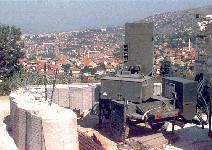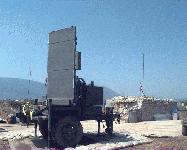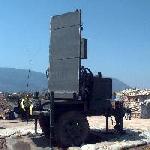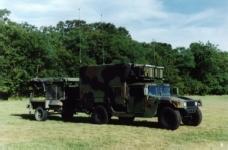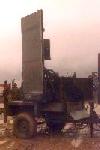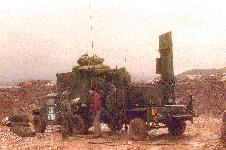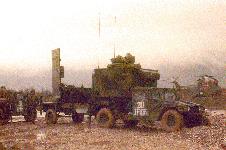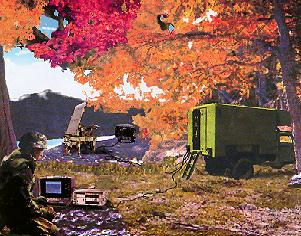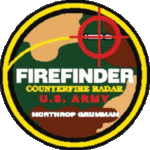 The AN/TPQ-36 Firefinder Radar is a lightweight, small, highly mobile radar set capable of detecting weapon projectiles launched at any angle within selected 90-degree azimuth sectors over 360 degrees of coverage. The AN/TPQ-36 can locate simultaneous and volley-fire weapons. It can also be used to register and adjust friendly fire. Upon projectile detection, the weapon location is computed and is used to direct counter-battery fires.
The system consists of an operational control group, OK-398/TPQ-36, and an antenna transceiver group, OY-71/TPQ-36. It is used by the artillery battalions to provide an effective capability to locate hostile weapons, both mortars and short- to medium-range weapons.
The AN/TPQ-36 Firefinder Radar is a lightweight, small, highly mobile radar set capable of detecting weapon projectiles launched at any angle within selected 90-degree azimuth sectors over 360 degrees of coverage. The AN/TPQ-36 can locate simultaneous and volley-fire weapons. It can also be used to register and adjust friendly fire. Upon projectile detection, the weapon location is computed and is used to direct counter-battery fires.
The system consists of an operational control group, OK-398/TPQ-36, and an antenna transceiver group, OY-71/TPQ-36. It is used by the artillery battalions to provide an effective capability to locate hostile weapons, both mortars and short- to medium-range weapons.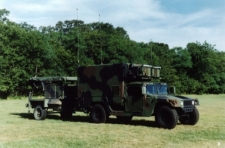 The Marine Corps will be receiving a Version 8 configuration, currently involving Toby Hanna Army Depot & Grumman Electronics Programs. This new configuration consists of a new Operations Control Group (OCG) using the Army Lightweight Multipurpose Shelter (LMS) mounted on a M1097 HMMWV. This HMMWV tows the Antenna Transceiver Group (ATG) with the integrated Modular Azimuth Positioning System (MAPS) mounted on the M116A2E1 trailer. The OCG is controlled by an operator either located within the shelter or remotely located. The second M1097 HMMWV will carry the MEP112A generator mounted on an M116A2E1 trailer. An additional reconnaissance vehicle/crew carrier, a fourth HMMWV, will be added to the Marine Corps Table of Equipment.
The Marine Corps will be receiving a Version 8 configuration, currently involving Toby Hanna Army Depot & Grumman Electronics Programs. This new configuration consists of a new Operations Control Group (OCG) using the Army Lightweight Multipurpose Shelter (LMS) mounted on a M1097 HMMWV. This HMMWV tows the Antenna Transceiver Group (ATG) with the integrated Modular Azimuth Positioning System (MAPS) mounted on the M116A2E1 trailer. The OCG is controlled by an operator either located within the shelter or remotely located. The second M1097 HMMWV will carry the MEP112A generator mounted on an M116A2E1 trailer. An additional reconnaissance vehicle/crew carrier, a fourth HMMWV, will be added to the Marine Corps Table of Equipment.The AN/TPQ-36(V) was originally developed in the 70�s and fielded in the early 80�s. 130 systems were built for the US Army and Marine Corps. The system has proven to be very effective in numerous situations and continues to be used by the Army, Marines, National Guard and many Foreign Military Sales Customers. However, as the system ages, it is increasingly difficult to obtain many of the components. The system�s reliability is also degrading.
The AN/TPQ-36(V)7 (HMMWV Version), downsized the AN/TPQ-36 configuration for the active force. The AN/TPQ-36(V)7 is a highly mobile short range radar which can locate mortars, artillery and rockets within the accuracy of that weapons system. It was downsized from 5-ton trucks (in the (V)5 configuration) to M1097 HMMWV's which improved it's mobility. The operations control group is mounted on an M1097 HMMWV that tows the M116a2 cargo trailer. A second M1097 HMMWV carries a MEP 112A generator and tows the Antenna Transciever Group (ATG) mounted on a modified M116A2 trailer. The M998 HMMWV reconnaissance vehicle tows a second MEP 112a generator mounted on a second M116A2 cargo trailer. A Modular Azimuth Positioning System (MAPS) gives a self-survey capability. It has memory keep alive circuits which allow an operator to shut power to the system off and not lose stored data. As long as there is power in the vehicle battery, memory is maintained. Downsizing of vehicles allowed for downsizing the crew from 8 to 6 personnel. The new configuration will have a drive on/off capability and can be transported in two sorties by C-130 and larger aircraft. The system can be helicopter lifted. Fielding of the AN/TPQ-36(V)7 was completed the third quarter of 1995.
PM FIREFINDER initiated the development of a new Operations Central (OC) in the early 1990�s to replace the OCG. Although this has resolved the problems with the radar electronics, no improvements have been made to the ATG since its inception. While the development of the new OCG was on-going, PM Forward Area Air Defense (FAAD) Sensors selected a derivative of the AN/TPQ-36(V) ATG for the Ground Based Sensor (now Sentinel) program. This variant, the AN/MPQ-64(V), was initially 85% common with the AN/TPQ-36(V) ATG. However, during the course of producing the AN/MPQ-64(V), numerous parts were identified that were either no longer procurable, or newer, more efficient parts had became available. As a result, many new parts were identified and incorporated in the production. An initial review of the improvements made to the AN/MPQ-64(V) ATG showed that many of the new parts may be F3 compatible with the AN/TPQ-36(V). Others may require some Non-Recurring (NRE) to develop kits to facilitate installation. An IPT was established between the FIREFINDER and SENTINEL communities to identify those components that are directly plug-in compatible and those that will require some NRE to incorporate.The AN/TPQ-36(V)8 (electronics upgrade) provides reduced emplace and displace times, faster access to data, increased memory and digital map storage, a new high speed signal processor for processing up to 20 targets per minute, remote operations up to 100 meters from ATG, and an enhanced probability of detection. These changes will be accomplished by: a new hard disk drive; a flat panel display/control unit, a signal/data processorand a portable laptop computer mounted in a Lightweight Multi-Purpose Shelter (LMS). The AN/TPQ-36(V)8 will use the same antenna as the AN/TPQ-36(V)7. A low noise amplifier is switched for a newer one which will (with version 11 software) help reduce false locations. The heart of the system is the new Operations Central (OC) which has a new, smaller but more powerful signal processor. The new shelter uses common hardware/software to provide operator interface with the new signal processor. The Pentium based LCU's use a windows like environment to make operations as simple as "point and click." There are full size color monitors for visuals and a map plotter for reference. A CD-ROM device will allow for use of digital tactical elevation data (DTED) on CD-ROM as well as a 1.275 GB hard drive for storage of operational and maintenance programs and other data. The new signal processor is the cornerstone of the upgrade. It will allow for processing more targets per minute with 90% correct target classification. False locations will be reduced. Operations will be remotable by removing the left LCU and configuring the Control Display Terminal (CDT).
Primary function: Mobile radar set.
Manufacturer: Hughes Aircraft Company
Length:
Shelter: 106 inches (269 centimeters)
Antenna/transceiver: 181.1 inches (459 centimeters)
Width:
Shelter: 82.7 inches (210.06 centimeters)
Antenna/transceiver: 82.7 inches (210.06 centimeters)
Height:
Shelter: 70.9 inches (180.09 centimeters)
Antenna/transceiver:
In operation: 145.7 inches (370 centimeters)
In transit: 82.7 inches (210 centimeters)
Weight:
Shelter: 2,400 pounds (1089.6 kilograms)
Antenna/transceiver: 3,200 pounds (1452.8 kilograms)
Power requirements: 115/200 VAC, three-phase, four-wire, 400 Hz, 10kw
Support equipment: two M923 five-ton trucks, two 10kw generators
Units: Headquarters batteries in artillery regiments, counter-battery radar platoons
Crew: 9 enlisted
Introduction date: January 1985
Unit Replacement Cost: $1,548,500
Marine Corps Inventory: 22
